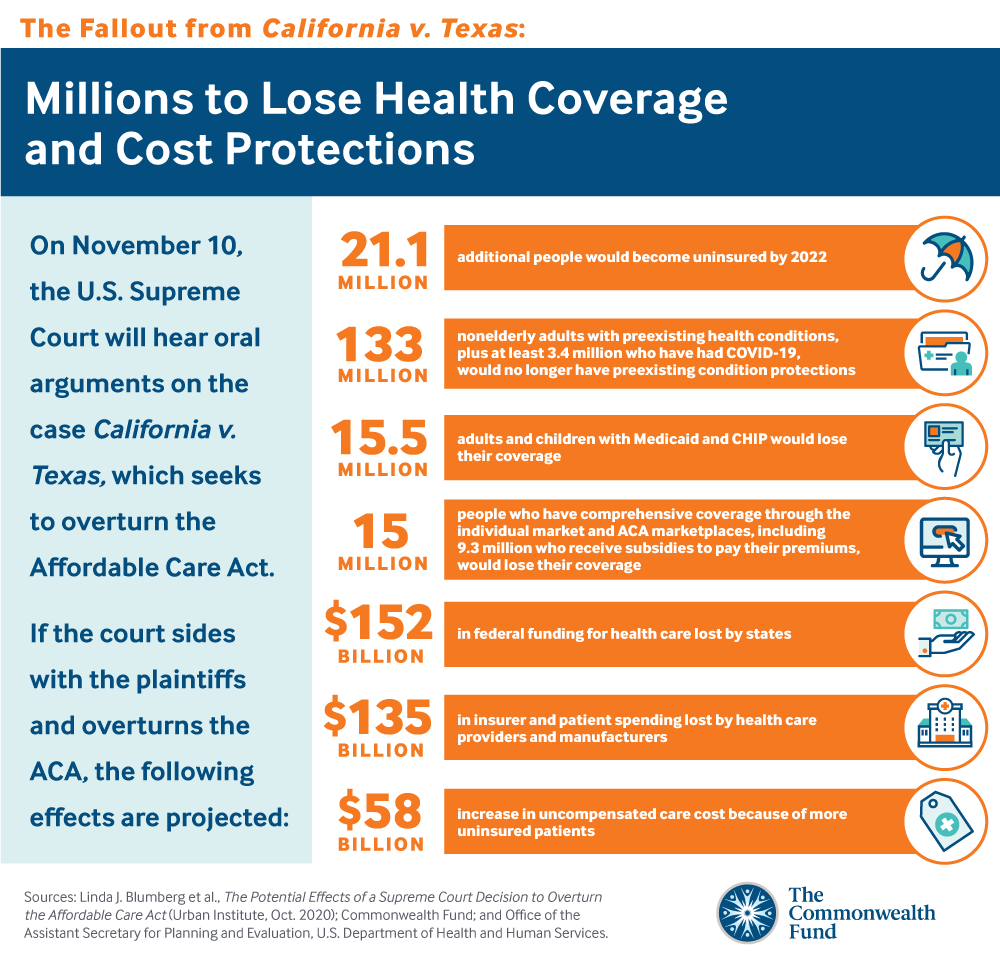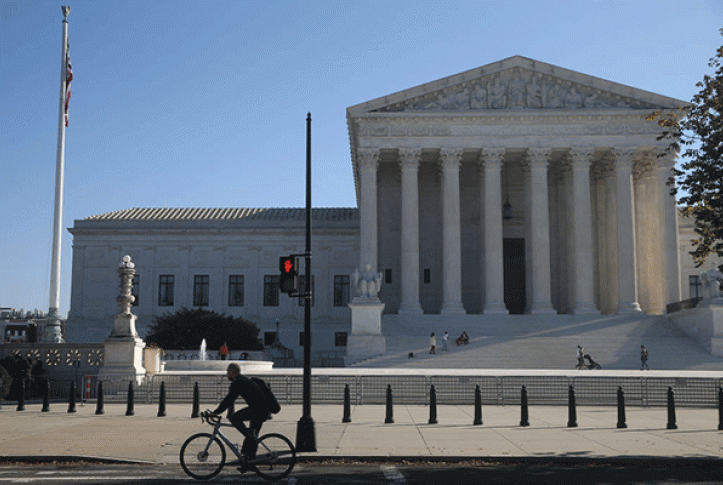The Affordable Care Act’s (ACA) open-enrollment period — when consumers can shop and sign up for health care on the marketplaces — is now underway. The number of Americans seeking coverage in the marketplaces this fall may exceed last year’s figure because millions have lost jobs and job-based health insurance during the pandemic. In addition, the fear of COVID-19 may drive other uninsured people to the marketplaces in search of protection from an illness that can be severe and costly.
But 10 days into the open enrollment period, on November 10, the Supreme Court will hear oral arguments in a case that seeks to overturn the ACA. In the middle of a raging pandemic, with more than 56,000 people currently hospitalized with COVID-19, the justices will hear arguments from Republican attorneys general in 18 states and the Trump administration that the law should be struck down. Their argument focuses on the law’s individual mandate. In 2012, the Supreme Court ruled the mandate was constitutional because of the penalty, which it considered a tax. However, in 2017, a Republican-led Congress eliminated the penalty associated with the mandate. The plaintiffs argue that without the penalty the mandate is unconstitutional. They further argue that the mandate is central to the functioning of the law; therefore, the rest of the law cannot stand without it.
The case is widely viewed as weak among legal scholars. The plaintiffs argue that people are harmed by the mandate, but the elimination of the penalty means that there is no longer a cost to go without coverage. Second, the individual market appears to be functioning well without the penalty. Insurers have said they view the premium subsidies as sufficient incentive to attract enough people, including healthy people, to buy insurance and maintain a stable risk pool. If that were not true, only sicker people would have purchased coverage and premiums would have spiked, prompting insurers to leave the market. Instead, the Trump administration announced in October that premiums for plans sold in the federal marketplaces declined by 8 percent between 2019 and 2021 while the number of insurers offering plans increased.
What to Expect
Though the Court will not issue a ruling until 2021, the oral arguments could offer clues to several key questions. First, will a majority of the justices agree that the plaintiffs have standing to sue on the basis of alleged harm caused by the mandate when there is no longer a tax associated with forgoing insurance? Second, if a majority concludes the plaintiffs do have standing, will they rule the mandate is unconstitutional without the penalty? Third, if a majority holds the mandate unconstitutional, is it “severable” from the rest of law —that is, can the mandate be struck down and the rest of the law left intact? If not, which parts of the law cannot be severed from the mandate and must also fall?
If a majority decides the mandate is unconstitutional, the issue of severability will become central. There are at least three possible outcomes:
- Scenario One: A majority decides the mandate is severable, leaving the rest of the ACA intact.
- Scenario Two: A majority decides the mandate is not severable from the law’s individual insurance market reforms, including preexisting condition protections.
- Scenario Three: A majority decides the mandate is not severable from the entire law, striking down the ACA.
What It Means
- Scenario One: The ACA will continue to function as it does now.
- Scenario Two: The individual market would look much like it did before the ACA.
- 133 million nonelderly adults with preexisting health conditions, plus at least 3.4 million who have had COVID-19, would no longer have protections if they needed to buy coverage on their own
- Young women, older people, and smokers would face substantially higher premiums or be unable to get covered at all
- Few health plans if any would cover maternity care or provide it at additional cost
- Insurers and employers could place annual and lifetime limits on the amount they will pay, leaving people with potentially catastrophic medical costs in the case of a serious accident or illness
- Insurance companies could cancel policies if someone became sick.
- Scenario Three: In addition to the effects under Scenario Two, overturning the ACA would trigger massive disruption to American’s insurance coverage and drain revenue from states and health care providers. The Urban Institute and others have estimated the potential damage:
- 21.1 million additional people would become uninsured by 2022
- 15.5 million adults and children with coverage through Medicaid and the Children’s Health Insurance Program would lose their insurance
- 15 million people who have comprehensive coverage through the ACA marketplaces and individual market, including 9.3 million who receive premium subsidies, would lose their coverage
- States would lose $152 billion in federal funding for health care
- Without health insurance, people spend less on health care, leaving providers and health care manufactures like pharmaceutical companies with $135 billion in lost revenue
- Uncompensated care would increase by $58 billion because more patients are uninsured
- More than 150 million people with job-based insurance would no longer be entitled to free preventive care; they also would lose the ability to keep their children on their policies to age 26
- Wide racial and income inequities in health insurance coverage that have been partly remedied by the ACA would return. The uninsured rate would rise to 20 percent among Black people, 30 percent among Hispanic people, 24 percent among American Indian and Alaska Natives, 19 percent among Asian and Pacific Islanders, and 15 percent among white people.

The implications of Scenario Three would extend far beyond insurance coverage. The health care industry represents nearly 20 percent of the nation’s economy; the ACA has touched every corner. The law restructured the individual and small-group health insurance markets, expanded and streamlined the Medicaid program, improved Medicare benefits, and reformed the way Medicare pays doctors, hospitals, and other providers. It was a catalyst for the movement toward value-based care and established a regulatory pathway for biosimilars — less expensive versions of biologic drugs. States have rewritten laws to incorporate the ACA’s provisions. Insurers, hospitals, physicians, and state and local governments have invested billions of dollars adjusting to these changes.
What Will the Administration and Congress Do Next?
President-elect Biden has pledged to protect and build on the ACA. The Biden administration and Congress could attempt to render the case moot by passing legislation to eliminate the mandate from the ACA. It is uncertain how the Court would react to such an action. The health of millions of Americans and the functioning of the health system itself now rests in the hands of nine justices.





